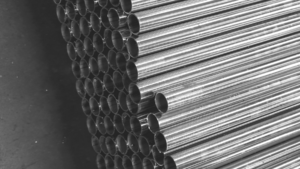Impact testing is a type of destructive test that the team here at Special Piping Materials organises regularly and is just one of the value-added services that we can provide.
Impact testing is a specific way to measure the durability – or ‘toughness’ of a particular material. Brittle materials have low toughness, whereas strong materials have high toughness. Interestingly, a material’s toughness does not stay constant but can be impacted by the environment it is in. For example, if it is in a particularly cold environment, or a corrosive one.
Most of the duplex or super duplex piping specifications that we receive from our clients have a requirement for a low temperature impact test but it’s not a standard requirement from ASTM.
What is impact testing?
Impact Testing measures how much energy a material can absorb and endure at high velocity before it fractures. In essence, it is a quality control method that is employed in order to ensure that a material will perform in a certain way when it is in situ.
The type of impact testing we will be focusing on in this blog is ‘Charpy Impact Testing’ – sometimes known as ‘V-Notch’ testing. Impact testing as we know it today – a pendulum fracture test – was first introduced by S.B. Russell in 1896. In 1901 Georges Charpy ‘improved’ the test by proposing a standardised method with a redesigned pendulum and notched sample, thus giving more precise specifications.
Here are some examples of when and why Charpy Impact Testing is used:
- – Subsea: Impact testing carried out on super duplex pipe in a test condition of -50 ˚c in order to determine whether the material will be able to perform at extremes of temperature in subsea environments.
- – The integrity of welds: The ‘fusion zone’ in the welded joints of a stainless steel piping structure can often have a duplex structure. This means it consists of both austenite and ferrite phases and thus the molecular make-up and durability of the weld must be checked.
- – Cryogenic: A test environment of -196˚C is created and an impact test carried out in this condition to check whether the material will still be durable in this extreme situation – where liquid nitrogen is used for example.
Charpy Impact Testing is a type of destructive testing. Destructive testing works by a material being intentionally pushed to its limits until it ‘fails’ so the point of failure can be analysed and recorded. Destructive testing is widely used in heavy industries and can be effectively used to determine the durability of a material before it is relied upon to perform in the wider market.
There are many advantages of destructive testing:
- – Confirms the unique properties of a material
- – Helps to lessen the chance failures, accidents and costs
- – Can determine impact resistance
- – Used to analyse ductility
- – Can produce information about yield and ultimate tensile strength, fracture toughness and fatigue strength.
- – Is often an essential aspect of engineering critical assessments
- – Predicts the service life of a product
- – Can help to determine the metallurgy and molecular level of a particular item
What is the process of Charpy Impact Testing?
Charpy Impact testing apparatus mainly comprises of a pendulum with a hammer that is of a known mass and length. The process is as follows:
- A standardised notched sample (the dimensions of the notch and size of the sample are very important) of the material that is being tested is held in place in a central horizontal position by a set of support anvils.
- A pendulum with a hammer that is of a known mass and length is swung from a pre-determined height.
- The amount of energy transferred to the material can then be calculated and analysed by comparing the difference in the height of the hammer before and after the fracture.
- The material’s toughness is then determined based on the calculations of the energy transfer.
Charpy tests are often carried out many times at many different temperatures. This means that charts can be plotted to demonstrate when a material will ‘fail’ in a particular environment.
The usual test methods and specifications that are followed are:
- – ASTM A370
- – ASTM E23
- – ASTM E208
- – ISO 148
The advantages of Charpy Impact Testing
Some of the benefits of Charpy Impact Tests are:
- – It is a relatively cost-effective test method to check for composites
- – It is a fairly easy to perform
- – Helps to accurately assess the quality of a product
- – Very helpful when evaluating new products to be used in new environments
- – Yields quick measurement results
SPM and Impact Testing
Special Piping Materials is very experienced with carrying out and organising a wide variety of destructive testing, with Charpy Impact Testing being one of them.
We only work with ISO17025 accredited testing houses and all of our stock test pieces are prepared and tested in accordance with ASTM A370. Our super duplex and duplex stock on our shelves have been impact tested at -50˚C as standard on wall thicknesses over 6mm.
If a client has a different requirement to this then we can do whatever is necessary – a bespoke and personal service always puts the customer’s needs first!
According to ASTM A370:
- – The standard specimen size for Charpy impact testing is 10 mm × 10 mm × 55 mm.
- – The subsize specimen sizes are: 10 mm × 7.5 mm × 55 mm, 10 mm × 6.7 mm × 55 mm, 10 mm × 5 mm × 55 mm, 10 mm × 3.3 mm × 55 mm, 10 mm × 2.5 mm × 55 mm.
Speak to your account manager at Special Piping Materials today to arrange the specific testing your project requires.
#destructivetesting #stainlesssteel #duplex #superduplex #testing #quality #specialpipingmaterials #ImpactTesting #Charpy #Service #Bespoke
